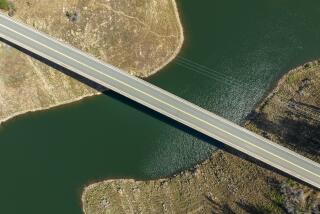MWD vote moves Colorado River drought plan forward

The Metropolitan Water District of Southern California on Tuesday sealed California’s participation in a landmark Colorado River drought management plan, agreeing to shoulder more of the state’s future delivery cuts to prevent Lake Mead from falling to dangerously low levels.
With California signed on, the plan can move to Congress, which must approve the multi-state agreement before it takes effect.
The MWD board took the step over the objections of the Imperial Irrigation District, which holds senior rights to the biggest allocation of river water on the entire length of the Colorado.
The sprawling Imperial Valley agricultural district has refused to sign the drought plan until the federal government provides $200 million for restoration of the Salton Sea, and its intransigence has forced California to miss federal deadlines for joining the pact.
Nearly two decades of drought have depleted the river and the big reservoirs that supply farms and cities from Colorado to Southern California. Federal water managers have repeatedly warned that the time is approaching when they will have to formally declare a shortage, triggering a cascade of river rationing.
MWD executives have said it is vital that the drought plan go into effect as soon as possible to prevent Lake Mead from dropping to levels that jeopardize Hoover Dam’s hydropower production and, eventually, water releases. They worry that if a shortage is declared, the agency would lose access to its substantial Lake Mead reserves.
Under the drought contingency plan, Arizona and Nevada would be the first to reduce their withdrawals from Lake Mead. If the huge reservoir drops farther, California would cut back, spreading its reductions across the MWD, Imperial and other agencies that use the river.
With no federal funding for the Salton Sea on the immediate horizon, MWD leaders said they would assume responsibility for Imperial’s share of the cuts to push California across the finish line.
Imperial protested and raised the threat of legal action in a letter it sent to the board on Monday.
Noting that the MWD’s river rights are junior to Imperial’s, Imperial General Manager Henry Martinez argued that the move amounted to a major change that should trigger an environmental review.
“It is an unbelievable assumption ... that only one minor modification will be needed for a lower priority water rights holder to sign multiple agreements on behalf of a senior priority water rights holder,” Martinez wrote. “By changing — in a way that the public cannot readily understand or see — the project description … at the last moment, MWD has violated both the letter and spirit” of California’s Environmental Quality Act.
Metropolitan General Manager Jeffrey Kightlinger told the board Tuesday that agency attorneys had reviewed Imperial’s letter and said no environmental review was necessary. Without any discussion, the board then unanimously approved a motion to finalize California’s part of the shortage deal.
“However well-meaning MWD’s action is intended, it is simply unworkable and unacceptable to take the IID and the Salton Sea out of the [drought plan] equation,” Imperial board President Erik Ortega said in a statement after the vote.
The seven states that rely on Colorado supplies have been working on the drought plan for years.
U.S. Bureau of Reclamation Commissioner Brenda Burman recently pressured the states to finish, saying the Interior Department will develop its own shortage directives if the states don’t soon agree and send the plan to Congress.
In a Saturday letter to the Colorado River Board of California, the six other river states urged California to immediately approve the shortage plan. All six have agreed to it, although Arizona is still completing its documentation. According to Kightlinger, reclamation bureau attorneys said the MWD could sign for California.
Imperial leaders have said they intend to join the pact but won’t ink the final documents until the federal government commits to funding Salton Sea restoration.
The Salton Sea is sustained by irrigation runoff from the Imperial Valley. As the district has sold some of its river water to San Diego, both irrigated acreage and field runoff have declined, causing the lake to shrink.
As the shoreline recedes, parts of a lakebed laced with agricultural chemicals and other pollutants have turned to dust, fouling the air. The lake has also grown increasingly salty, worsening its already bad water quality.
All that was anticipated when the San Diego water sales were agreed to more than a decade ago. The state and federal governments promised costly restoration programs. But they have been slow to materialize.
The Imperial Irrigation District “is not seeking to delay the [drought contingency plan] process,” Martinez wrote. “IID only requests that we address the Salton Sea before proceeding with the [drought plan] rather than ‘kicking the can down the road’ one more time.”
Burman has supported federal funding for Salton Sea restoration, but has declined to link it to the drought plan.
If Imperial later signs the shortage documents, the MWD says it would be relieved of picking up Imperial’s share of the cuts.
Twitter: @boxall
More to Read
Sign up for Essential California
The most important California stories and recommendations in your inbox every morning.
You may occasionally receive promotional content from the Los Angeles Times.











